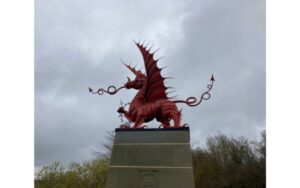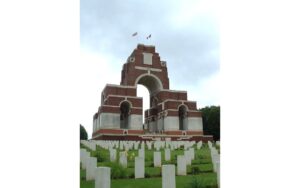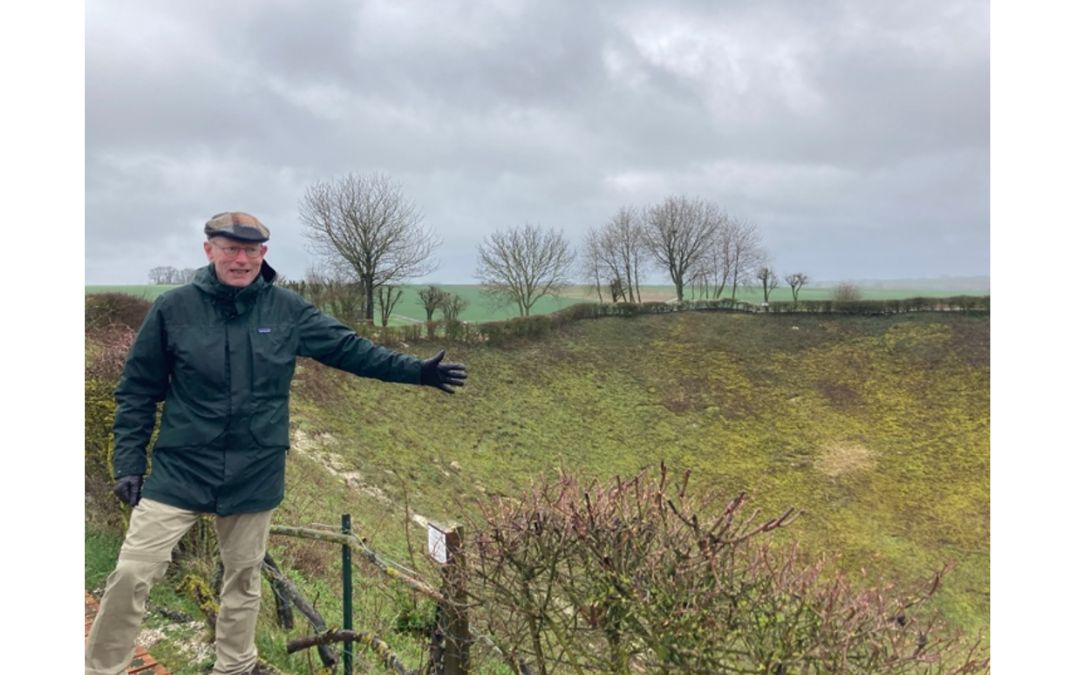CADS Trip to The Somme, France – 31st March to 2nd APRIL 2023
Members of CADS, BRITSOC, and friends, 22 in total, led by John Cameron-Webb, our expert guide and leader, joined the trip to The Somme. We all know John as a long-time CADS member, former British Consul Amsterdam, Jokathon winner (2021) and talented musician. However, he is also a man with a great passion for, and a detailed knowledge of, military history of World War I battlefield sites. Some of the group enjoyed visiting Ypres with John last year, but most had never visited the area around the Somme before.
Despite challenging rain throughout most of Saturday, and a biting wind on Sunday, we were inspired by John to venture out to experience, for ourselves, the open and bleak landscape that formed the battle front on the Somme between July and November 1916. Some of the highlights of the trip are included below.
The featured photo shows John describing the Lochnagar Crater formed by an underground explosive charge, secretly planted by the British during the preparations for the first day of the Battle of the Somme. The mine was detonated at 7:28 a.m. on 1 July 1916, minutes before the men were sent over the top and into battle. It left a crater 21 metres deep and 100 wide.
Devonshire Trench Cemetery
The cemetery was established on a section of the old front line trench in Mansel Copse. This ground had originally been held by troops of the 9th Devons before the attack towards the German positions in Mametz on 1 July. Casualties were extremely heavy. The inscription on this stone reads: ‘The Devonshires held this trench, the Devonshires hold it still’. The cemetery contains the graves of 163 soldiers, including Lieutenant William Noel Hodgson, Military Cross (MC), a war poet.

The red dragon and stone plinth of Mametz Wood Memorial commemorates an engagement of the 38th (Welsh) Division of the British Army during the First Battle of the Somme in July 1916.
The men forming the first wave intending to take the wood in a matter of hours. However, strong resistance killed and injured over 400 soldiers before they even reached it. Fighting continued over many days until it was captured, but with further heavy casualties.
Thiepval Memorial to the Missing of the Somme
Designed by Sir Edwin Lutyens and unveiled in 1932, it is the largest British war memorial in the world and bears the names of 72,337 British and South African men who fought on the Somme. Located on a small rise, and prominent on the skyline, it is certainly one of the most moving sights along the old front line. No visit is complete without a stop here.

An inscription on the memorial reads:
“Here are recorded the names of officers and men of the British Armies who fell on the Somme battlefields July 1915 February 1918 but to whom the fortune of war denied the known and honoured burial given to their comrades in death”.
Ulster Tower
Located in Thiepval, this is Northern Ireland’s National War Memorial. It was one of the first memorials to be erected on the Western Front and commemorates the men of the 36th (Ulster) Division and all those from Ulster who served in the First World War. Volunteer “Piper Anja”, pictured here, entertained us in the museum next door as we took shelter from the rain.

Newfoundland Memorial Park at Beaumont Hamel.
This park stretches over an area of 84 acres and was purchased by the Newfoundland Government in the 1930s and is one of five memorial sites known as the Trail of the Caribou. It contains preserved trenches, shell craters and several memorials. It gives the visitor a clear idea of the front lines and the lack of protection available to the troops.
At its heart stands a great bronze caribou – the emblem of the Royal Newfoundland Regiment. It watches over the rolling fields where many fell and have no known resting place.
The Newfoundlanders are an example of how patriotic the colonial populations were in 1914. In August 1914, large numbers of Newfoundland’s young men volunteered for service with the British Army. They sailed from St. John’s in a ship jointly financed by all those on board and arrived in Britain without any weapons or equipment whatsoever. With the sole exception of the West Yorks Regiment, theirs suffered the highest number of casualties.
Delville Wood South African Memorial at Longeuval gave yet another poignant reminder of the huge loss of life across the Commonwealth. People from all Commonwealth nations, totalling over one million, fell in the Great War and, of whom, the majority rest in France. The inscription on the entrance to the memorial reads: “Their Ideal is Our Legacy, Their Sacrifice Our Inspiration”.
Many poets served in the forces on the Somme. We were treated to a selection of their work read by one of our group, Annette Roodhart, as we visited some of the sites which inspired them to write. Together with her trusty batman, Pieter, who was often needed to hold an umbrella, Annette recited examples of the works of many of the well-known WWI poets and some not so well known. One such was Mary Borden, an American heiress who founded a field hospital behind the allied lines and later wrote “The Forbidden Zone”.
“They shall grow not old, as we that are left grow old: Age shall not weary them, nor the years condemn. At the going down of the sun and in the morning
We will remember them.” from For the Fallen by Laurence Binyon
John had quite rightly warned that: “visiting the places where such events took place is a very powerful experience, it helps us understand the challenges faced by both commanders and front-line soldiers.” The addition of poetry into the itinerary served to further enhance the first-hand experience of the battlefields and made the occasion even more poignant and meaningful. Without doubt many lasting memories were made on this trip and we look forward to a return visit to Ypres later in the year.

